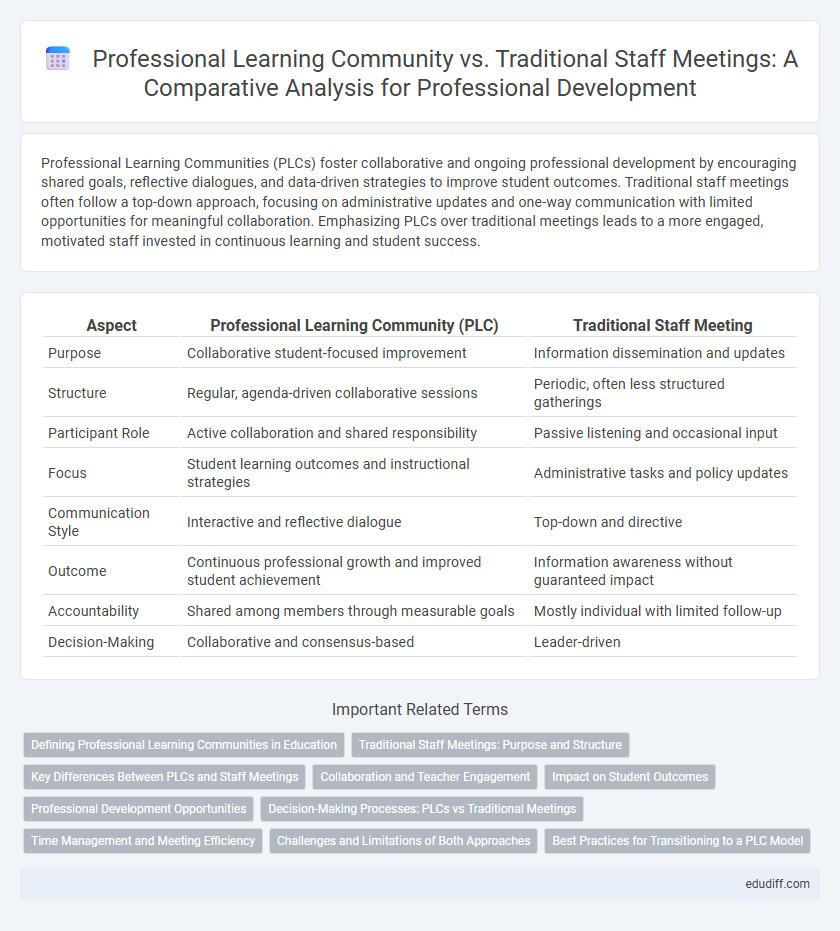Professional Learning Communities (PLCs) foster collaborative and ongoing professional development by encouraging shared goals, reflective dialogues, and data-driven strategies to improve student outcomes. Traditional staff meetings often follow a top-down approach, focusing on administrative updates and one-way communication with limited opportunities for meaningful collaboration. Emphasizing PLCs over traditional meetings leads to a more engaged, motivated staff invested in continuous learning and student success.
Table of Comparison
| Aspect | Professional Learning Community (PLC) | Traditional Staff Meeting |
|---|---|---|
| Purpose | Collaborative student-focused improvement | Information dissemination and updates |
| Structure | Regular, agenda-driven collaborative sessions | Periodic, often less structured gatherings |
| Participant Role | Active collaboration and shared responsibility | Passive listening and occasional input |
| Focus | Student learning outcomes and instructional strategies | Administrative tasks and policy updates |
| Communication Style | Interactive and reflective dialogue | Top-down and directive |
| Outcome | Continuous professional growth and improved student achievement | Information awareness without guaranteed impact |
| Accountability | Shared among members through measurable goals | Mostly individual with limited follow-up |
| Decision-Making | Collaborative and consensus-based | Leader-driven |
Defining Professional Learning Communities in Education
Professional Learning Communities (PLCs) in education are collaborative groups of educators focused on continuous improvement through collective inquiry, data-driven decision-making, and shared practices to enhance student achievement. Unlike traditional staff meetings that primarily involve administrative updates, PLCs prioritize collaborative problem-solving, ongoing professional development, and alignment of teaching strategies to meet diverse student needs. Emphasizing sustained interaction and mutual accountability, PLCs create a culture of trust and a commitment to evidence-based instructional improvement.
Traditional Staff Meetings: Purpose and Structure
Traditional staff meetings primarily serve as a platform for disseminating administrative updates, organizational announcements, and policy changes to ensure all staff members are informed. Typically structured with a fixed agenda, these meetings follow a hierarchical format where information flows from leadership to staff, allowing limited interactive discussion. The purpose centers on maintaining operational coherence and routine communication rather than collaborative problem-solving or professional development.
Key Differences Between PLCs and Staff Meetings
Professional Learning Communities (PLCs) emphasize collaborative, ongoing learning focused on improving student outcomes through shared goals, data analysis, and reflective practice. Traditional staff meetings primarily serve as communication platforms for administrative updates and policy dissemination without the structured, continuous cycle of inquiry that defines PLCs. Unlike staff meetings, PLCs foster collective responsibility, accountability, and a culture of continuous improvement driven by teacher collaboration and evidence-based discussions.
Collaboration and Teacher Engagement
Professional Learning Communities (PLCs) foster collaborative environments where teachers actively engage in shared goal-setting, data analysis, and reflective dialogue, enhancing instructional practices. Traditional staff meetings often lack sustained collaboration and limit teacher involvement to passive information receipt. The structured interaction in PLCs drives continuous professional growth and collective responsibility, resulting in higher teacher motivation and improved student outcomes.
Impact on Student Outcomes
Professional Learning Communities (PLCs) foster collaborative teacher engagement, promoting data-driven instruction and continuous improvement, leading to measurable gains in student achievement and deeper understanding. Traditional staff meetings often prioritize administrative updates and lack sustained focus on instructional strategies, resulting in limited influence on student performance. Research consistently demonstrates that PLCs enhance teacher effectiveness and student outcomes by emphasizing shared goals, peer support, and evidence-based practices.
Professional Development Opportunities
Professional Learning Communities (PLCs) offer structured, collaborative environments where educators engage in continuous professional development through shared goals, data analysis, and instructional strategies. Unlike traditional staff meetings that often focus on administrative updates, PLCs prioritize ongoing skill enhancement and reflective practice, fostering a culture of collective growth. The targeted nature of PLCs leads to improved teaching effectiveness and student outcomes by emphasizing evidence-based professional learning opportunities.
Decision-Making Processes: PLCs vs Traditional Meetings
Professional Learning Communities (PLCs) emphasize collaborative decision-making based on student data analysis and shared goals, fostering collective responsibility among educators. Traditional staff meetings often rely on top-down decision-making with limited input from participants, leading to less dynamic problem-solving. PLCs enhance decision quality and implementation effectiveness by promoting continuous dialogue and reflective practice.
Time Management and Meeting Efficiency
Professional Learning Communities (PLCs) optimize time management by structuring focused, agenda-driven discussions that prioritize collaborative problem-solving, resulting in higher meeting efficiency compared to traditional staff meetings. Unlike traditional meetings that often suffer from unfocused dialogue and time overruns, PLCs implement targeted action plans and accountability measures to maximize productivity within limited time frames. Data shows PLCs reduce average meeting duration by 30%, while increasing participant engagement and actionable outcomes significantly.
Challenges and Limitations of Both Approaches
Professional Learning Communities (PLCs) face challenges such as time constraints, inconsistent participation, and varying levels of commitment, which can undermine collaborative goals. Traditional staff meetings often suffer from limited engagement, one-way communication, and lack of actionable outcomes, reducing their effectiveness in fostering professional growth. Both approaches are constrained by organizational culture and resource allocation, highlighting the need for tailored strategies to maximize staff development impact.
Best Practices for Transitioning to a PLC Model
Transitioning to a Professional Learning Community (PLC) model requires clear communication of shared goals, structured collaboration time, and ongoing data analysis to inform instructional practices. Establishing trust and collective responsibility among staff members enhances engagement and accountability, differentiating PLCs from traditional staff meetings that often lack focused, outcome-driven dialogue. Integrating best practices such as consistent scheduling, facilitation training, and use of student achievement data fosters a culture of continuous improvement and professional growth.
Professional Learning Community vs Traditional Staff Meeting Infographic

 edudiff.com
edudiff.com